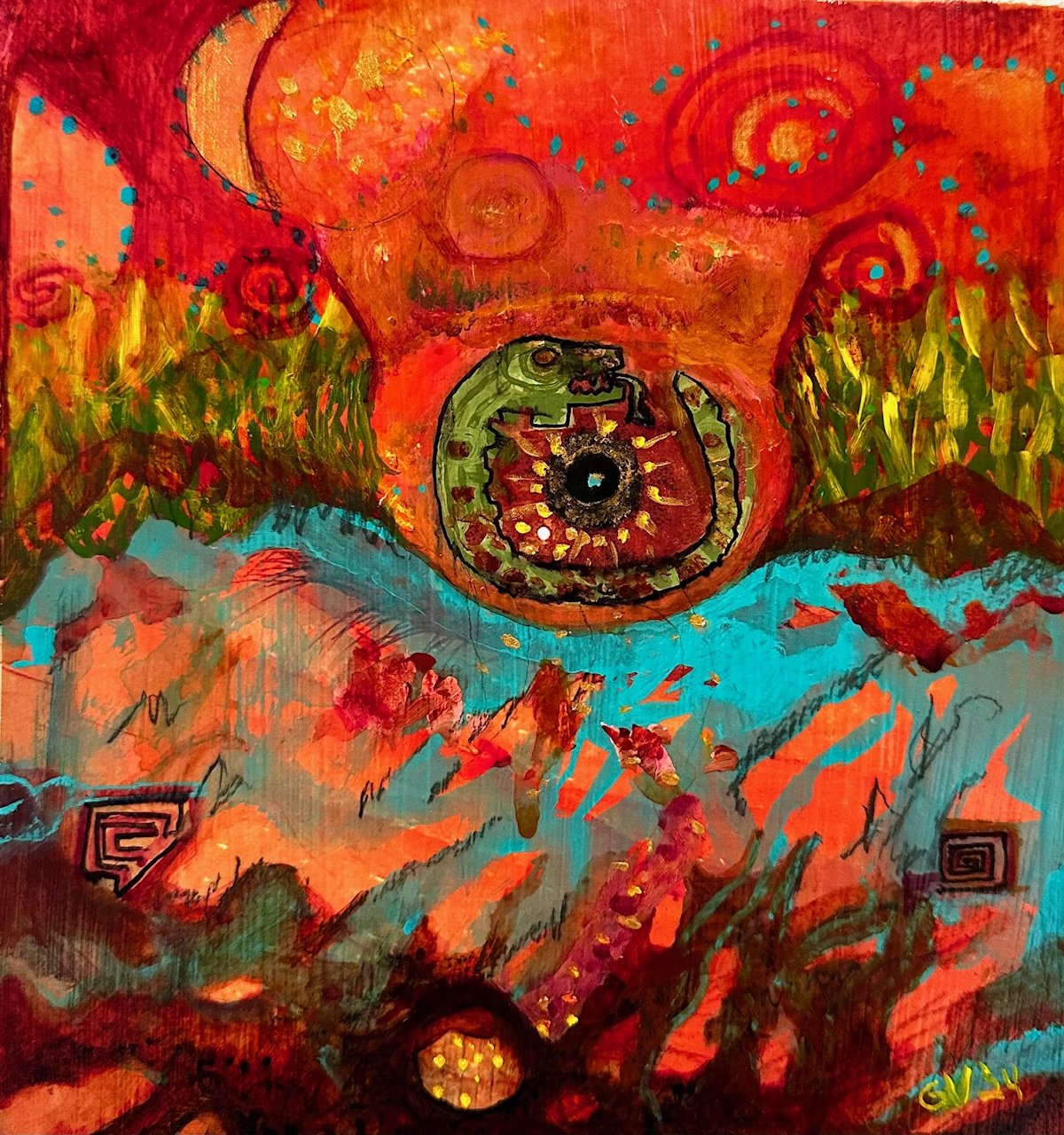 Image 1 of 1
Image 1 of 1


Divine Humanity
"Divine Humanity" is a profound and symbolically rich artwork that draws upon ancient Mesoamerican mythology to explore the complex duality of human existence and the cyclical nature of life, death, and rebirth.
The central figure of the painting is Quetzalcoatl, the Feathered Serpent deity revered by the Toltec, Aztec, and Mayan cultures. This powerful being is depicted in a dynamic pose that emphasizes its dual nature:
The feathered aspect of Quetzalcoatl represents humanity's divine aspect, our capacity for higher thought, spiritual connection, and transcendence.
The serpentine lower half of Quetzalcoatl grounds the figure, coiling or undulating across the earth. This portrays our earthly, physical nature - our connection to the material world and our place among all living creatures.
The background of the painting juxtaposes celestial and terrestrial elements. The sky might feature ethereal colors or cosmic imagery, while the earth below is rich and fertile, teeming with life and hidden potential.
A key element of the composition is the depiction of the "fertile underworld." This is visualized as a cross-section of earth, revealing layers beneath the surface. Here, there is decaying matter transforming into nutrients, seeds germinating, and new roots reaching downward. This imagery reinforces the theme of death and rebirth, illustrating how endings become beginnings in the cycle of life.
There is abundant plant life emerging from the soil, symbolizing growth, renewal, and the fruits of transformation. These plants are in various stages of development, from seedlings to full bloom, emphasizing the continuous nature of growth and change.
The overall composition of "Divine Humanity" creates a sense of movement and flow, with spiral or circular elements that reinforce the concept of cycles and transformation. The eye might be drawn to follow the form of Quetzalcoatl from earth to sky and back again, mirroring the journey of the soul between physical and spiritual realms.
This artwork invites viewers to contemplate their own dual nature - the interplay between their earthly existence and divine potential. It encourages reflection on how we can integrate these seemingly opposing aspects of ourselves, finding balance and wholeness.
Moreover, "Divine Humanity" serves as a powerful reminder of life's regenerative power. It suggests that what appears to be an ending is often the beginning of something new, and that our challenges and losses can become the fertile ground from which new growth emerges. The painting ultimately celebrates the transformative journey of human existence, honoring both our earthly roots and our capacity for spiritual elevation.
Museum quality canvas prints available:
Stretched Canvas: 16” x 16” $150.00
Unstretched Canvas: 16” x 16” $95.00
"Divine Humanity" is a profound and symbolically rich artwork that draws upon ancient Mesoamerican mythology to explore the complex duality of human existence and the cyclical nature of life, death, and rebirth.
The central figure of the painting is Quetzalcoatl, the Feathered Serpent deity revered by the Toltec, Aztec, and Mayan cultures. This powerful being is depicted in a dynamic pose that emphasizes its dual nature:
The feathered aspect of Quetzalcoatl represents humanity's divine aspect, our capacity for higher thought, spiritual connection, and transcendence.
The serpentine lower half of Quetzalcoatl grounds the figure, coiling or undulating across the earth. This portrays our earthly, physical nature - our connection to the material world and our place among all living creatures.
The background of the painting juxtaposes celestial and terrestrial elements. The sky might feature ethereal colors or cosmic imagery, while the earth below is rich and fertile, teeming with life and hidden potential.
A key element of the composition is the depiction of the "fertile underworld." This is visualized as a cross-section of earth, revealing layers beneath the surface. Here, there is decaying matter transforming into nutrients, seeds germinating, and new roots reaching downward. This imagery reinforces the theme of death and rebirth, illustrating how endings become beginnings in the cycle of life.
There is abundant plant life emerging from the soil, symbolizing growth, renewal, and the fruits of transformation. These plants are in various stages of development, from seedlings to full bloom, emphasizing the continuous nature of growth and change.
The overall composition of "Divine Humanity" creates a sense of movement and flow, with spiral or circular elements that reinforce the concept of cycles and transformation. The eye might be drawn to follow the form of Quetzalcoatl from earth to sky and back again, mirroring the journey of the soul between physical and spiritual realms.
This artwork invites viewers to contemplate their own dual nature - the interplay between their earthly existence and divine potential. It encourages reflection on how we can integrate these seemingly opposing aspects of ourselves, finding balance and wholeness.
Moreover, "Divine Humanity" serves as a powerful reminder of life's regenerative power. It suggests that what appears to be an ending is often the beginning of something new, and that our challenges and losses can become the fertile ground from which new growth emerges. The painting ultimately celebrates the transformative journey of human existence, honoring both our earthly roots and our capacity for spiritual elevation.
Museum quality canvas prints available:
Stretched Canvas: 16” x 16” $150.00
Unstretched Canvas: 16” x 16” $95.00
